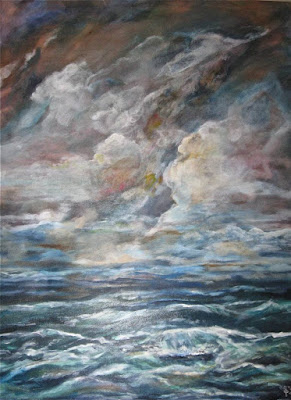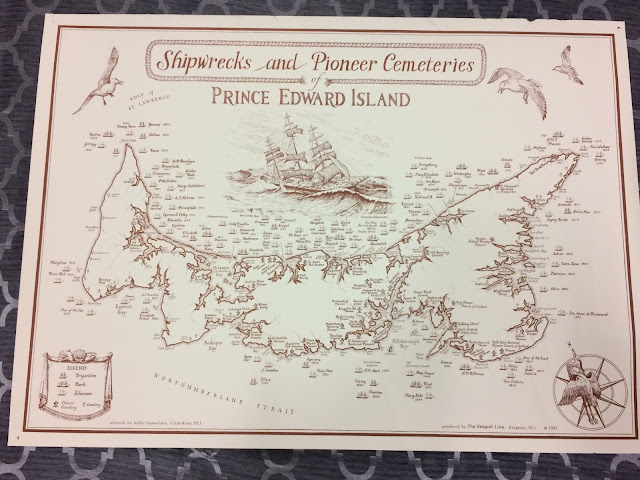The August Gale: A Deadly, But Somewhat Forgotten Storm in PEI History
The August Gale, AKA a hurricane, came on August 24, 1873. Unlike the Yankee Gale of 1851, there was more warning for this storm, allowing ships to anchor, crews to get to safety, and those on land to do some storm prepping. But, as we all know, that doesn't mean nothing bad will happen during a hurricane.
The track of the hurricane is unclear, but it seems when the storm was 900 nautical miles, about 1,600 kilometres, off the tip of Florida it changed course and headed north, towards Atlantic Canada. But, instead of getting weaker as it went over the warmer water, it got stronger. It could have absorbed another low-pressure system, the path could have avoided certain areas of warmer water, it isn't really clear what happened.
August 23 began as a nice, but cool day at 21 degrees. Temperatures steadily fell and the sky got more overcast as the day went on. It was very clear a storm was coming.
It is unknown how fast the wind was blowing - Henry Cundall, a businessman in Charlottetown and member of the still-developing Dominion Meteorological Service, had taken his anemometer in overnight for unknown reasons. Cundall was able to say that at 11 a.m. on Monday it was blowing at 59.55 kilometres per hour. He estimated that at the height of the storm, the wind would have been blowing at no less than 80 to 96 kilometres per hour. Francis Bain, a naturalist from North River stated that the wind direction was one point east of north.
Thankfully, many ships did make it into a harbour before the storm - the darkening sky and their barometers giving many a fair warning.
The Damage
By the late 1860s, PEI had a fleet of almost 400 Island-owned ships who participated in fishing and the shipping of goods. Every coastal community had captains, fishermen, shipping crews, etc. As you can image, this meant many were on the water during the August Gale.
Although there was some warning of the impending storm, it was bad enough that ships, despite being anchored in "safe areas", were thrown about and others were forced ashore.
Although fewer ships were wrecked on the Island coast compared to the Yankee Gale, the crews still aboard some of these ships were larger. As a result, 115-150 lives were lost off the coast of PEI. When the other Atlantic provinces are added, between 223 to 500 deaths are added to the count.
PEI was not in the direct path of the hurricane, however, the storm covered the Island. As a result, shipwrecks occurred on both the North and South shores. There were also clusters of wrecks at East Point and North Cape as they believed those would be good places to weather the storm. While many wrecked ships were fishing vessels, along the North Shore some larger cargo ships were also wrecked.
R.W. Dyer, Alberton's Anglican Minister was storm-stayed at a parishioner's home in Kildare Capes during the storm. You can tell from his writings he was very worried about the fishermen,
Early Reporting
Newspapers of the day often referred to the gale as "never seen before," "unprecedented," and "worst in memory." Island schooners were also reported to be wrecked off the coast off the coast of Nova Scotia.
John Hughes of Charlottetown lost the J.J. Marshall when the storm drove it 100 feet onto shore with seaweed reaching ten feet up the mast!
Some ships fared okay during the storm, such as the James Duncan. This ship was heading to Liverpool when it got caught in the gale. It made it to Pugwash Harbour where the fierce wind and tides pushed it and other vessels ashore. The James Duncan was lucky because the mud it was run ashore on was soft which protected the ship's hull. Once the ship's cargo was emptied crews were able to get her back in the water. Crews reloaded the ship and she headed out to Liverpool again - only a week behind schedule.
In Charlottetown, the water is reported to have reached Grafton Street in some areas!
Remembering the August Gale
I touched on this topic when I wrote about the Yankee Gale a few weeks ago. According to Dr. Edward Macdonald, "it was the fate of the August Gale to be to be gradually appropriated by the Yankee Gale through a fascinating process of cultural selection." Elements of the August Gale were incorporated into the stories of the Yankee Gale to explain the high death toll of that storm. Despite the Yankee Gale being an arguably less severe storm, the ships did not have the same advanced warning. Therefore, more ships (but smaller crews) were caught on the water.
This is interesting in that the Yankee Gale occurred in 1851, the August Gale in 1873, about 22 years apart - so there would be fishermen and other Islanders who lived through both storms. But, within thirty years, the August Gale was rather forgotten and the Yankee Gale was remembered.
Even finding sources about the August Gale is harder.
Why do we not remember the August Gale of 1873 as well as the Yankee Gale? We can hypothesis but we cannot know why for sure because it happened so long ago.
MacDonald, E. (2004). The August Gale and the Arc of Memory on Prince Edward Island. The Island Magazine 56, 9-20.
MacDonald, E. (2010). The Yankee Gale, the August Gale and Popular Culture on Prince Edward Island: A Meditation on Memory. The Dalhousie Review 90(1), 95-110.
 |
| August Gale by Joan Suzanne Salter. |
The track of the hurricane is unclear, but it seems when the storm was 900 nautical miles, about 1,600 kilometres, off the tip of Florida it changed course and headed north, towards Atlantic Canada. But, instead of getting weaker as it went over the warmer water, it got stronger. It could have absorbed another low-pressure system, the path could have avoided certain areas of warmer water, it isn't really clear what happened.
August 23 began as a nice, but cool day at 21 degrees. Temperatures steadily fell and the sky got more overcast as the day went on. It was very clear a storm was coming.
It is unknown how fast the wind was blowing - Henry Cundall, a businessman in Charlottetown and member of the still-developing Dominion Meteorological Service, had taken his anemometer in overnight for unknown reasons. Cundall was able to say that at 11 a.m. on Monday it was blowing at 59.55 kilometres per hour. He estimated that at the height of the storm, the wind would have been blowing at no less than 80 to 96 kilometres per hour. Francis Bain, a naturalist from North River stated that the wind direction was one point east of north.
Thankfully, many ships did make it into a harbour before the storm - the darkening sky and their barometers giving many a fair warning.
The Damage
By the late 1860s, PEI had a fleet of almost 400 Island-owned ships who participated in fishing and the shipping of goods. Every coastal community had captains, fishermen, shipping crews, etc. As you can image, this meant many were on the water during the August Gale.
Although there was some warning of the impending storm, it was bad enough that ships, despite being anchored in "safe areas", were thrown about and others were forced ashore.
Although fewer ships were wrecked on the Island coast compared to the Yankee Gale, the crews still aboard some of these ships were larger. As a result, 115-150 lives were lost off the coast of PEI. When the other Atlantic provinces are added, between 223 to 500 deaths are added to the count.
PEI was not in the direct path of the hurricane, however, the storm covered the Island. As a result, shipwrecks occurred on both the North and South shores. There were also clusters of wrecks at East Point and North Cape as they believed those would be good places to weather the storm. While many wrecked ships were fishing vessels, along the North Shore some larger cargo ships were also wrecked.
R.W. Dyer, Alberton's Anglican Minister was storm-stayed at a parishioner's home in Kildare Capes during the storm. You can tell from his writings he was very worried about the fishermen,
"There is no doubt but there will be an awful loss of life and vessels wrecked...the house is shaking greatly. Went to bed about 10 or 11 and it was still blowing a gale. Oh, what will become of those poor fishermen! The Lord have mercy on us... I never felt a house shake as Miss Travers' new house did...The trees - apple trees, plum trees, cherry trees, are blown and whipped to death."While it seems from this description that Dyer felt reasonably safe, the same couldn't be said for Angus MacMillan of Wood Islands. MacMillan went to the shore Sunday night to see the conditions when the tide quickly rose three feet with a "single wave." He had to get onto the roof of a "small cookhouse nearby, where he had to remain for hours, exposed to the pitiless storm, expecting every minute to be his last."
Early Reporting
Newspapers of the day often referred to the gale as "never seen before," "unprecedented," and "worst in memory." Island schooners were also reported to be wrecked off the coast off the coast of Nova Scotia.
John Hughes of Charlottetown lost the J.J. Marshall when the storm drove it 100 feet onto shore with seaweed reaching ten feet up the mast!
Some ships fared okay during the storm, such as the James Duncan. This ship was heading to Liverpool when it got caught in the gale. It made it to Pugwash Harbour where the fierce wind and tides pushed it and other vessels ashore. The James Duncan was lucky because the mud it was run ashore on was soft which protected the ship's hull. Once the ship's cargo was emptied crews were able to get her back in the water. Crews reloaded the ship and she headed out to Liverpool again - only a week behind schedule.
In Charlottetown, the water is reported to have reached Grafton Street in some areas!
Remembering the August Gale
I touched on this topic when I wrote about the Yankee Gale a few weeks ago. According to Dr. Edward Macdonald, "it was the fate of the August Gale to be to be gradually appropriated by the Yankee Gale through a fascinating process of cultural selection." Elements of the August Gale were incorporated into the stories of the Yankee Gale to explain the high death toll of that storm. Despite the Yankee Gale being an arguably less severe storm, the ships did not have the same advanced warning. Therefore, more ships (but smaller crews) were caught on the water.
This is interesting in that the Yankee Gale occurred in 1851, the August Gale in 1873, about 22 years apart - so there would be fishermen and other Islanders who lived through both storms. But, within thirty years, the August Gale was rather forgotten and the Yankee Gale was remembered.
Even finding sources about the August Gale is harder.
Why do we not remember the August Gale of 1873 as well as the Yankee Gale? We can hypothesis but we cannot know why for sure because it happened so long ago.
MacDonald, E. (2004). The August Gale and the Arc of Memory on Prince Edward Island. The Island Magazine 56, 9-20.
MacDonald, E. (2010). The Yankee Gale, the August Gale and Popular Culture on Prince Edward Island: A Meditation on Memory. The Dalhousie Review 90(1), 95-110.



Comments
Post a Comment